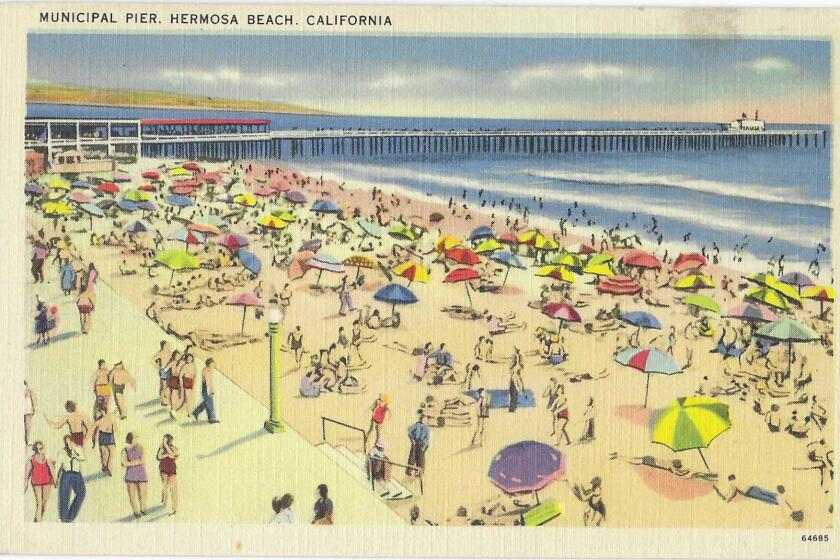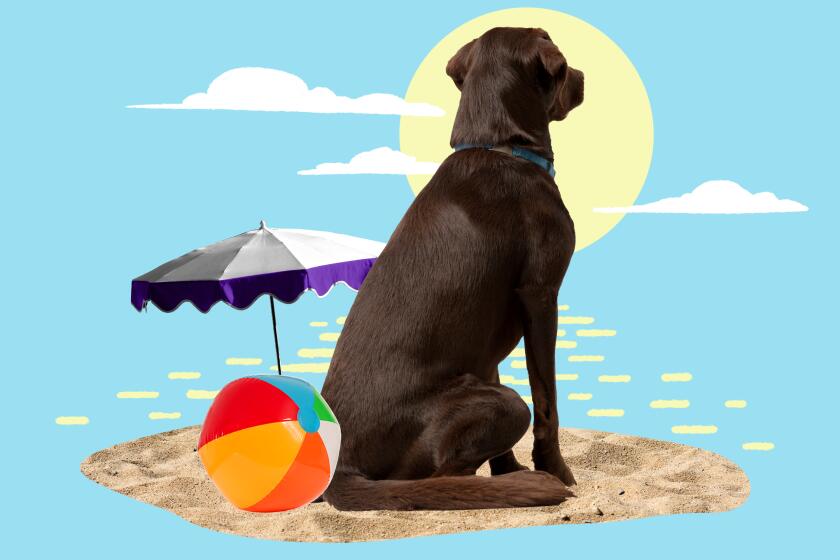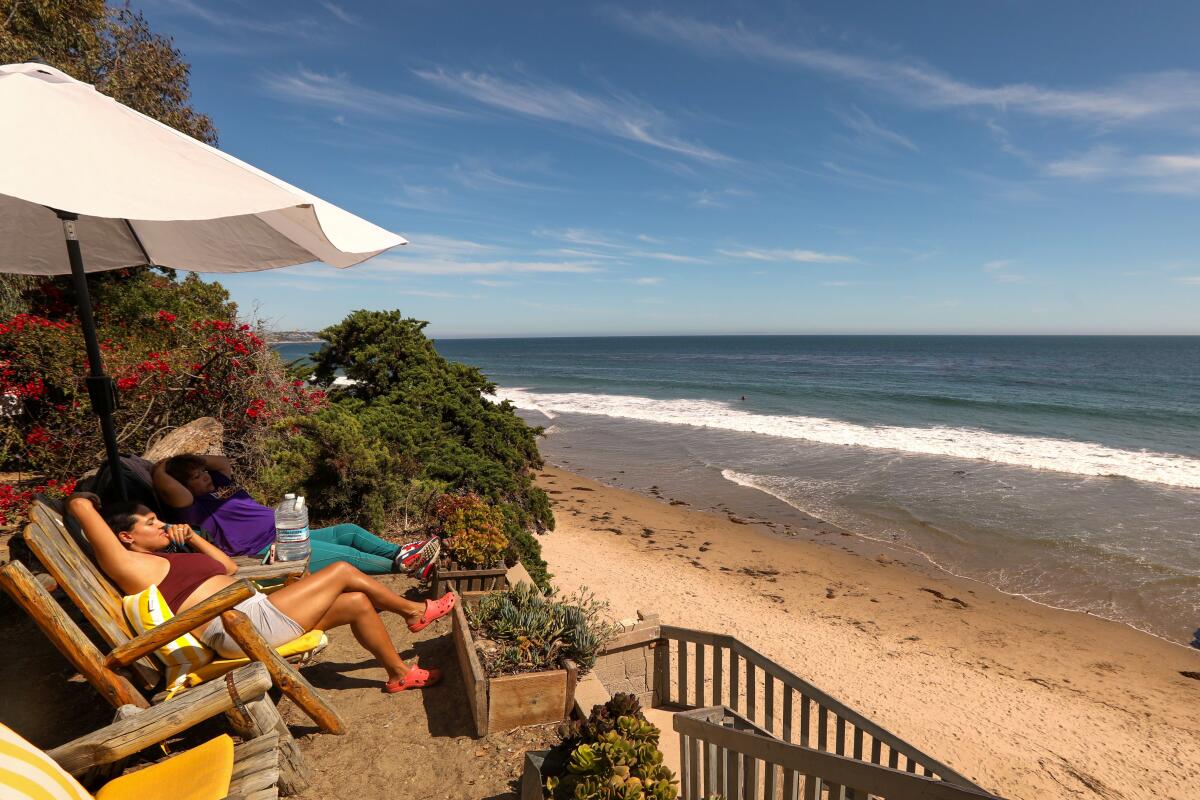
11 stunning Malibu beaches you can definitely visit — even if they look private
- Share via
With a natural coastline that stretches for 21 miles, Malibu is one of Los Angeles’ most prized beach towns. It’s the place where bronzed surfers flock to catch the perfect wave, Hollywood directors capture Oscar-worthy beach shots and the wealthy build their multimillion-dollar oceanfront homes.
You may be familiar with Malibu’s popular beaches, including Zuma, Surfrider and Topanga, but what about the ones that aren’t clearly visible when you’re driving along the Pacific Coast Highway?
Many of Malibu’s most breathtaking beaches are hiding in plain sight, tucked below luxurious homes often dotted with security cameras and caution signs that indicate private property. For years, affluent homeowners also posted illegal “no trespassing” and “private beach” signs, and hired security guards to shoo people away. All that could make a visitor question whether they could legally access these treasured spots. But the general rule is that if you’re on wet sand at a beach in California, you can absolutely be there.
The California Coastal Commission and its partner agency, the Mountains Recreation & Conservation Authority (MRCA) — which have been fighting to maximize public access at Malibu beaches over the years — have installed access ways along the coast and spooked those trying to deter beachgoers from exploring Malibu by enforcing hefty fines of $11,250 per day. Even so, officials say it’s an ongoing fight.
“I am not surprised by the misperception that beyond Zuma, there really aren’t any public beaches in Malibu,” says Linda Locklin, who has served as the commission’s coastal access program manager for nearly four decades. She notes that increased signage — blue-and-yellow round placards — for these hidden pathways has started to change that.
Visitors can look for the signs that say “Beach Access” and know they’re in the right spot — even if a security patrol car drives by or a landscaper stares at them while they’re walking in between tightly packed houses to reach a beach.
Will Rogers, Leo Carrillo and Dan Blocker were actors. Nicholas beach is named for a robber. Point Dume’s namesake is a priest. And other stories behind L.A. beach names.
Still, many aren’t hip to the various low-key spots like Escondido Beach, which has an access point on the side of a popular restaurant.
Luisa Virgen, 24, took her 20-year-old sister to Lechuza Beach on a recent Sunday morning — a spot she’s been frequenting since one of her college friends showed her the “secret beach” about six years ago.
When “he brought us, we thought the gate was closed, so we were like, ‘Do we have to jump the gate?’” she recalls. She was grateful that they didn’t have to do anything felonious to get to the little-known spot. Instead, they pushed open the pedestrian gate and walked through a residential neighborhood before reaching a staircase that led to the azure water and warm sand.
Virgen’s sister, Olivia, tried visiting Lechuza Beach on her own last summer but was unsuccessful, given the poor instructions she received from a friend.
“I like that it’s secluded,” Virgen says. “It feels like a private beach, so there’s not too many people. … If you know, you know.”
Below is a guide to Malibu’s off-the-beaten path beaches that appear private but aren’t. To locate them, I used the free Our Malibu Beaches smartphone app, which provides detailed instructions on how to find elusive access ways, where you can plop your towel on the dry sand and which “no parking” signs are legit. I also confirmed beach details with various public agencies, including state parks, the California Coastal Commission, MRCA and Los Angeles County, and visited the sites; the ones featured here were my favorites.
The app was created by environmental writer Jenny Price, journalist and entrepreneur Ben Adair and web and mobile developer John Adair. The California Coastal Commission also has its own free app, along with a physical guidebook, which is available for purchase.
“You need a lot of information to find and use these beaches,” says Price, noting that the app, which launched in 2013, has been downloaded more than 100,000 times. “You can see it really making actual change on the ground.”
Before we tackle the list, keep in mind:
- Some of these beaches offer multiple access points. Use the Our Malibu Beaches app to decide which is best for you.
- Although these beaches are open to the public — as long as you remain on the wet sand — you may still encounter someone who tries to tell you otherwise. If that happens, you can explain to them that you are indeed allowed on the beach and report the incident to the California Coastal Commission. (Note: I thankfully didn’t have any negative encounters while visiting these beaches.)
- Always check the local tide times for the entire day before heading off to the beach — especially for the smaller ones — as it’s safest to visit during low tide.
- Try to get to your beach of choice during daylight hours to avoid coming across a locked gate. (I experienced this at one of the Malibu Road Beach access points before sundown, when the gates are automatically set to close.)
- Dogs are technically not allowed on any of the beaches included on this list, though you may still see some. However, there is an exception for service animals.
- Although some of these beaches don’t have lifeguard towers, Los Angeles County Fire Department lifeguards — which offer 24/7 operations — will respond via rescue boats.
Which beaches in Los Angeles and Orange counties allow dogs? Check our list to find out.
Grab your beach day essentials — a lounge chair, towels, your favorite snacks and a juicy summer read — and don’t forget sunscreen. We’re headed to Malibu.
Planning your weekend? Stay up to date on the best things to do, see and eat in L.A.
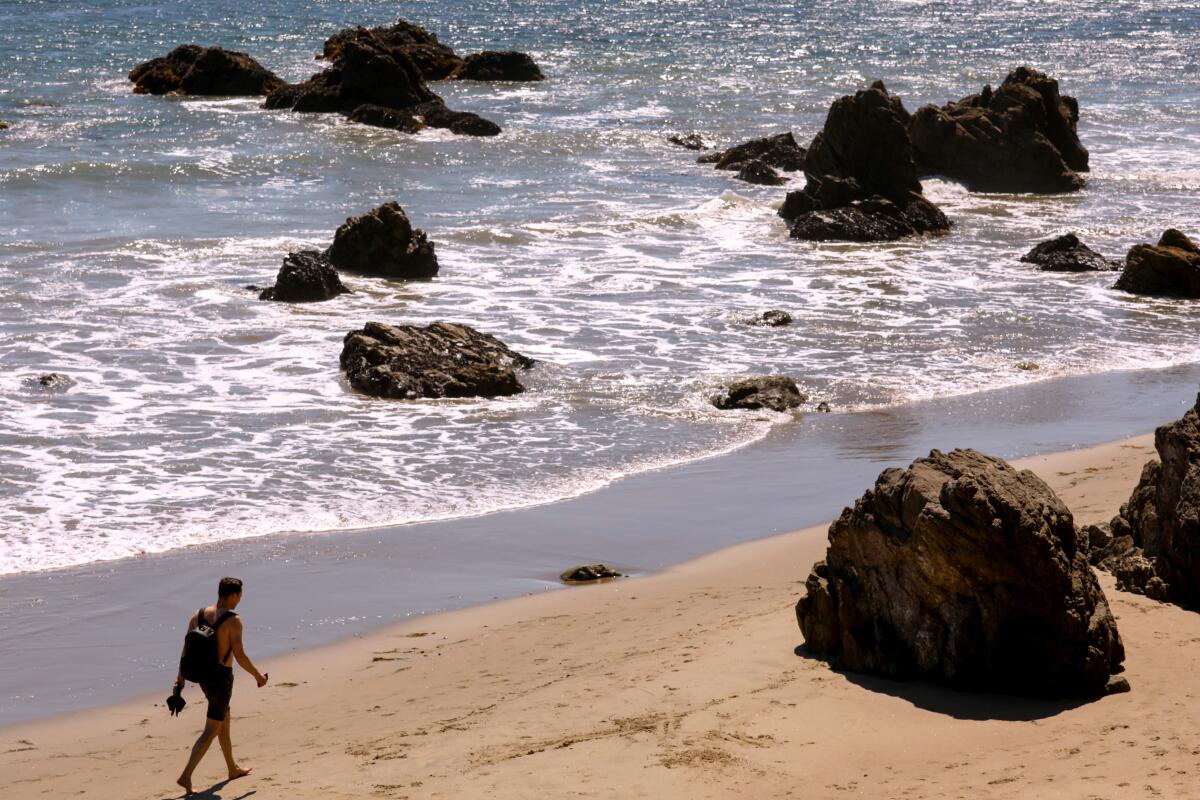
Lechuza Beach
Make your way down the driveway until you reach a black gate with a chocolate brown sign that reads “Lechuza Beach Access.” Push open the gate, then continue walking down a path for a few minutes through the neighborhood until you reach a moderate stairway that leads to the sandy beach. Take in Lechuza Beach’s alluring scenic views and stunning bluffs. Plus, it’s usually quiet even on weekends. Keep in mind that there aren’t any lifeguard towers or restrooms, though a permit application is currently before Malibu for an ADA-compliant restroom, according to the MRCA.
Escondido Beach
Once you’ve found parking on PCH — no easy feat given the healthy number of “no parking” signs on the highway — walk toward the valet lot for Geoffrey’s, a storied restaurant that’s been around since 1983. Near the entrance, you’ll see a brown coastal access sign and a “Hidden Beach” placard. Follow the arrows, which take you near the eatery’s patio (don’t worry about employees giving you weird looks — they’re used to people walking through the lot to get to the beach).
After you excuse yourself to walk past people waiting to be seated at the restaurant, push open a wooden gate and walk down a few flights of stairs until you reach the beach.
Escondido Beach, which is great for scuba diving, kayaking, sunbathing and beach-combing, gives off a remote vibe. Several lavish homes dot the beach, so use the app for reference to public easements to avoid wandering onto private property. Though dogs aren’t allowed on the beach, you likely will still see them here. There aren’t any restroom facilities at this beach.
If you’re feeling fancy after your long beach day, head back up to Geoffrey’s — where entrées range from $25 to $48 for lunch and $29 to $98 for dinner — to try the crab cakes or sautéed sea scallops.
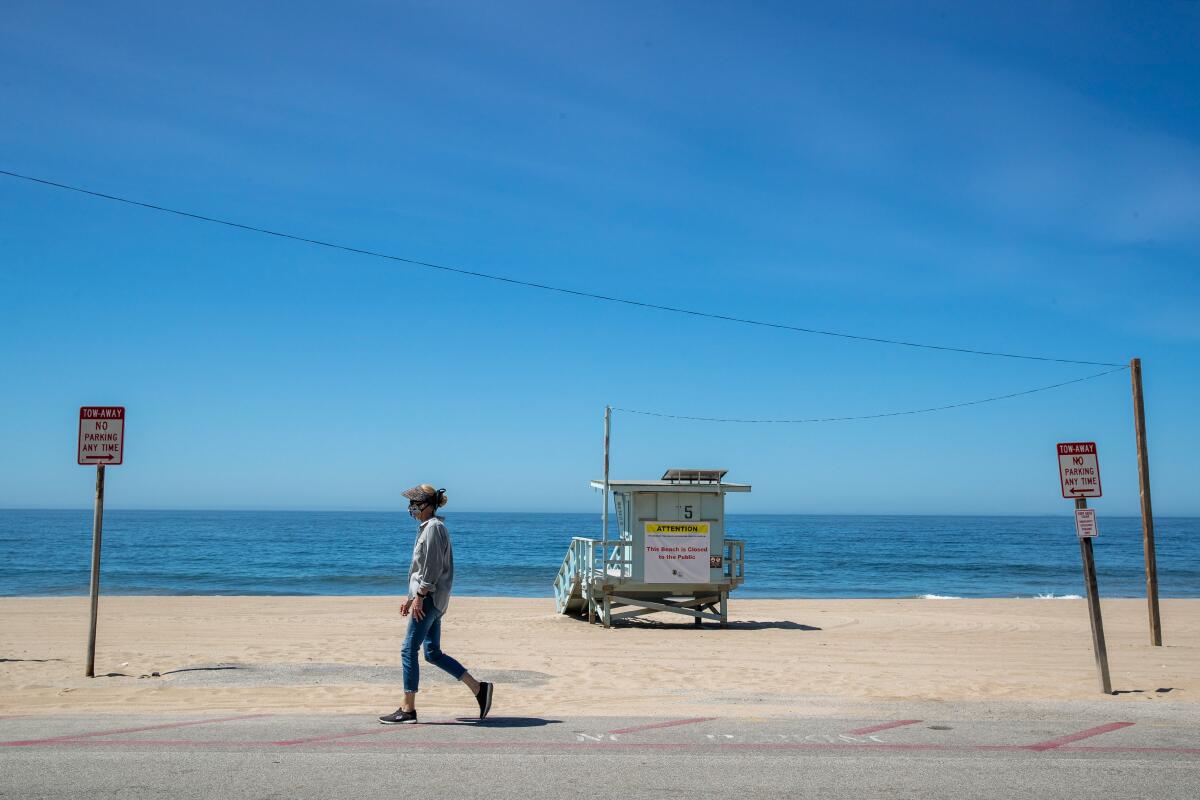
Point Dume State Beach
On a recent Friday morning, I opted to use the preserve pathway as directed by the Our Malibu Beaches app. After I miraculously secured one of roughly 10 parking spots — free for two hours — on a nearby street, I was surprised to see several surfers maneuvering down an uneven, dirt-filled cliff to get to the beach. (There’s also no lifeguard tower on this side of the beach.) There used to be a stairway but it’s currently under construction, according to the California Department of Parks and Recreation’s website. Instead of using the trail, I decided to drive a few minutes down Birdview Avenue until I reached a parking lot — next door to another beautiful beach known as Westward — that is monitored by an attendant during busy hours. During summer months, the parking lot costs no more than $8 on weekdays and $15 on weekends and county holidays.
This lot has ADA-compliant parking spaces and several restrooms, making Point Dume State Beach a great spot to take the family. There’s also a number of lifeguard towers on-site. At this beach, you’re likely to see people rock climbing, playing in the water and clambering over the entrancing rock formations. If you look closely, you might even spot a whale in the water.
Pro tip: If you find parking by what’s known as Westward Beach, along Westward Beach Road, you can just walk over to Point Dume State Beach to avoid paying for parking at the lot.
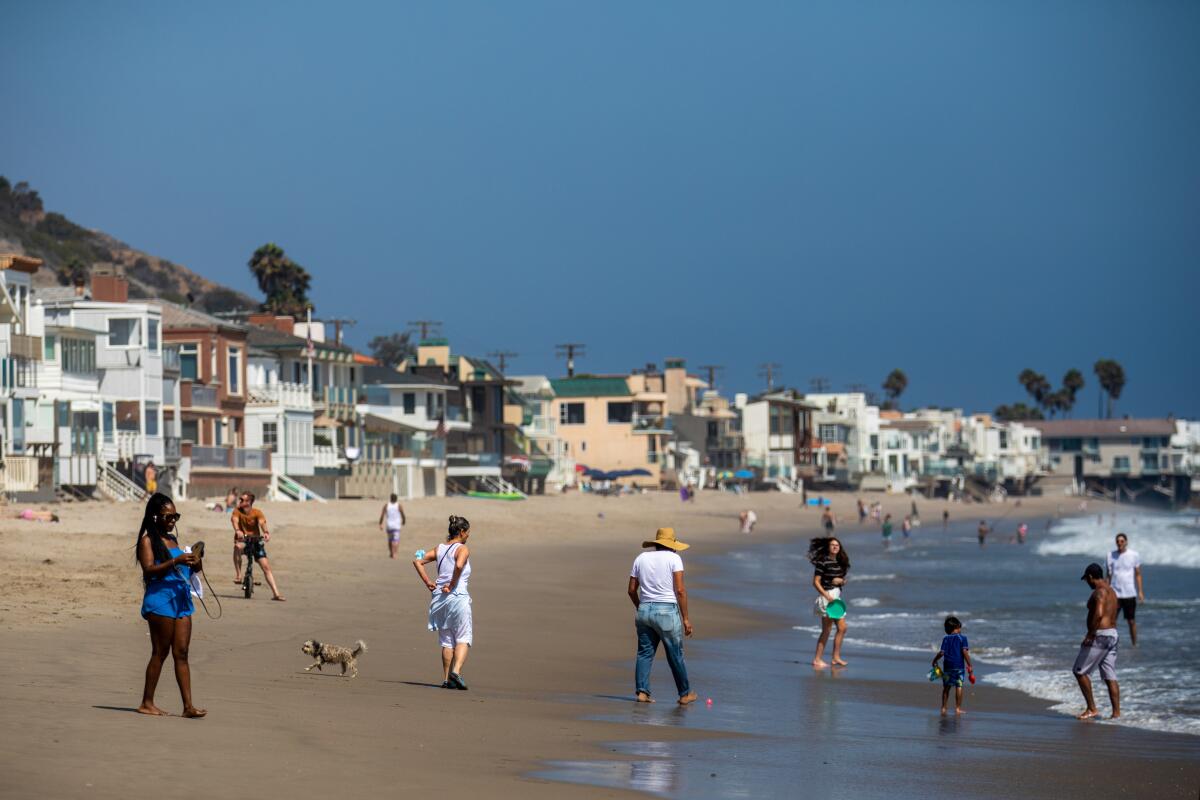
La Costa Beach
La Costa Beach usually isn’t jam-packed. It’s the spot to take yourself on a solo date to read, mediate, work on your journal or sunbathe in peace.
Parking on PCH is relatively easy in comparison to other Malibu beaches. In fact, most of the visitors I spoke with said they stumbled on La Costa Beach after struggling to find parking at nearby Carbon Beach. If you have to park on the northern side of the highway, use the crosswalk at Carbon Canyon Road.
Look for the trusty beach access placard, then hold onto the nearby gate so you can safely climb down a small set of boulders before placing your feet on the sand. There aren’t any restrooms or lifeguard towers. This beach is tide-dependent, meaning it goes under water during high tide, so check the local tide times before visiting. Dogs aren’t allowed, but don’t be surprised if you see a few.
Pro tip: There’s a sign with a QR code near the access point that you can scan, which will tell you where you can and cannot go on the beach — it’s part of a new program from the MRCA to raise public awareness.
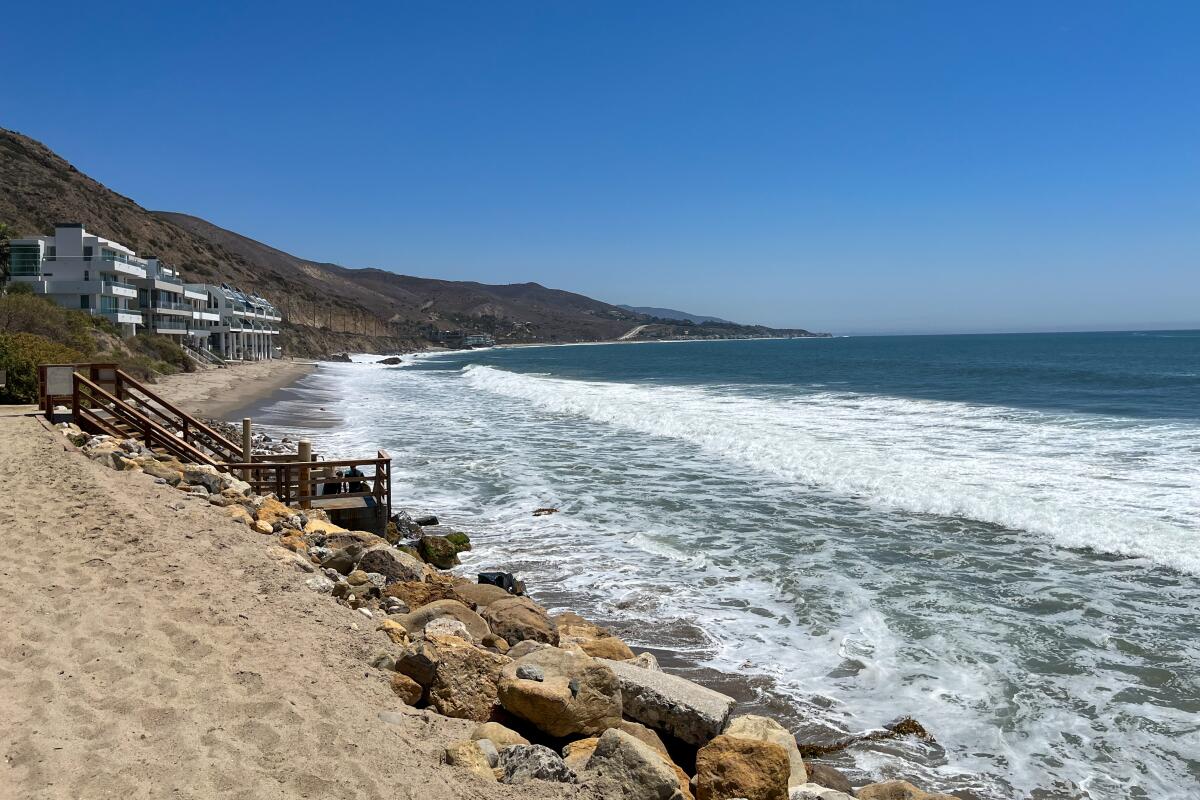
Latigo Beach
It may look like the personal backyard swimming pool for the residents of the Mediterranean-style condos above, but the vibe of this beach is much more welcoming. There’s also more than enough room for you to lounge and even listen to music — at a moderate volume, of course — without fear of disturbing others. You can place your towel on all the wet sand, as well as on the dry sand on the properties with public easements. The Our Malibu Beaches app tells you exactly where those are, but stay 16 feet from the first five condos and 10 feet from the next three.
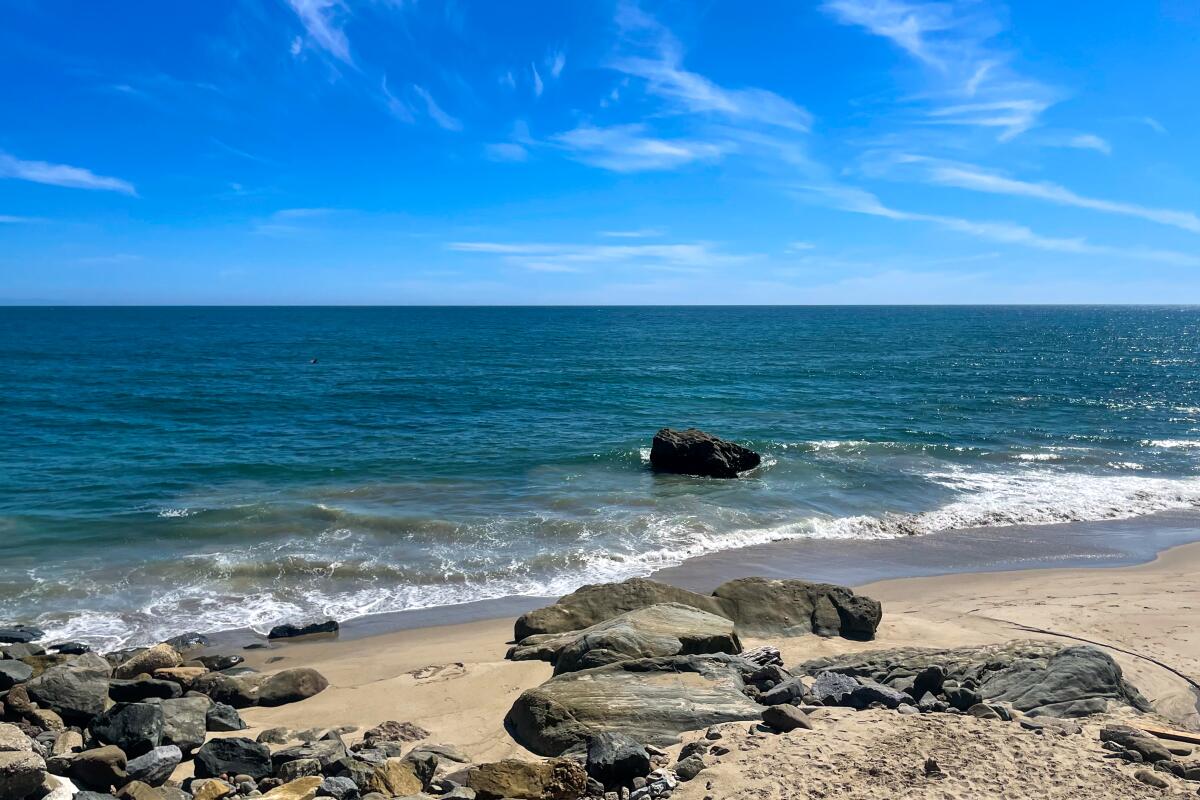
Big Rock Beach
As the name implies, Big Rock is a narrow and rocky pocket beach, but it’s worth checking out because not that many people are familiar with it yet. Of all the beaches I visited, it was the only place I saw someone fishing. If you’re lucky, you might even get the beach to yourself, and who doesn’t like the sound of that? The beach also has an ADA-compliant coastal overlook and an ADA-compliant bench.
Check the tide times before embarking here, as much of this beach can be submerged during high tide. The closest lifeguard tower is at Las Tunas Beach, about a mile away. You can also scan a barcode located at the entry gate to check the tide times. (Note: I visited access way No. 3 during high tide, and the water reached the end of the stairway.) When I visited on a weekday afternoon, it was a breeze to park on PCH near the access point. Push to open the pedestrian gate that leads to a moderate stairway, then voilà.
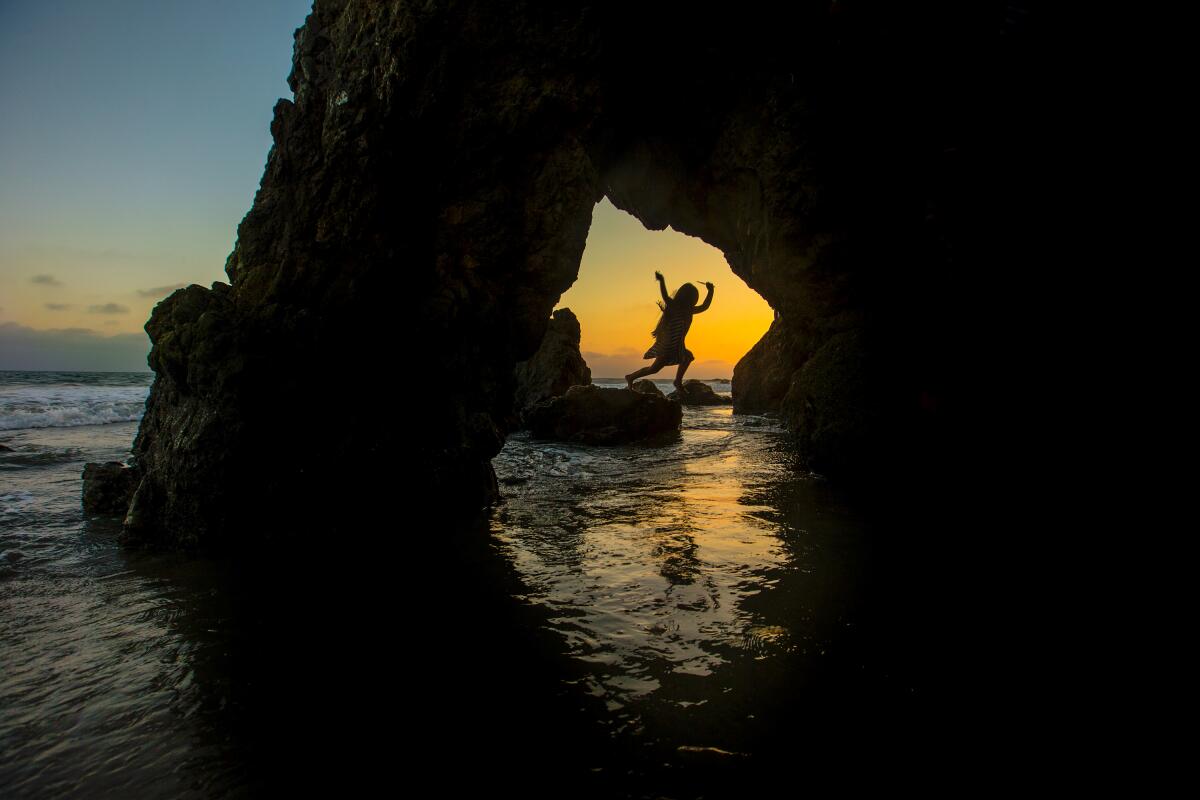
El Matador State Beach
El Matador is noted for its exquisite cliffs, unique rock formations and jagged caves, some of which you can explore during low tide. There’s one lifeguard tower on the bluff.
The beach also is known for having difficult parking, but the Instagram-worthy views make it worth the hassle. There’s a single parking lot that holds about 20 cars ($12 for the day or $3 for the hour), but it fills up quickly. There is one ADA parking space with ADA access to the restroom. If you get there at a busy time, you can either wait for another car to leave or park along PCH for free wherever you don’t see “no parking” signs.
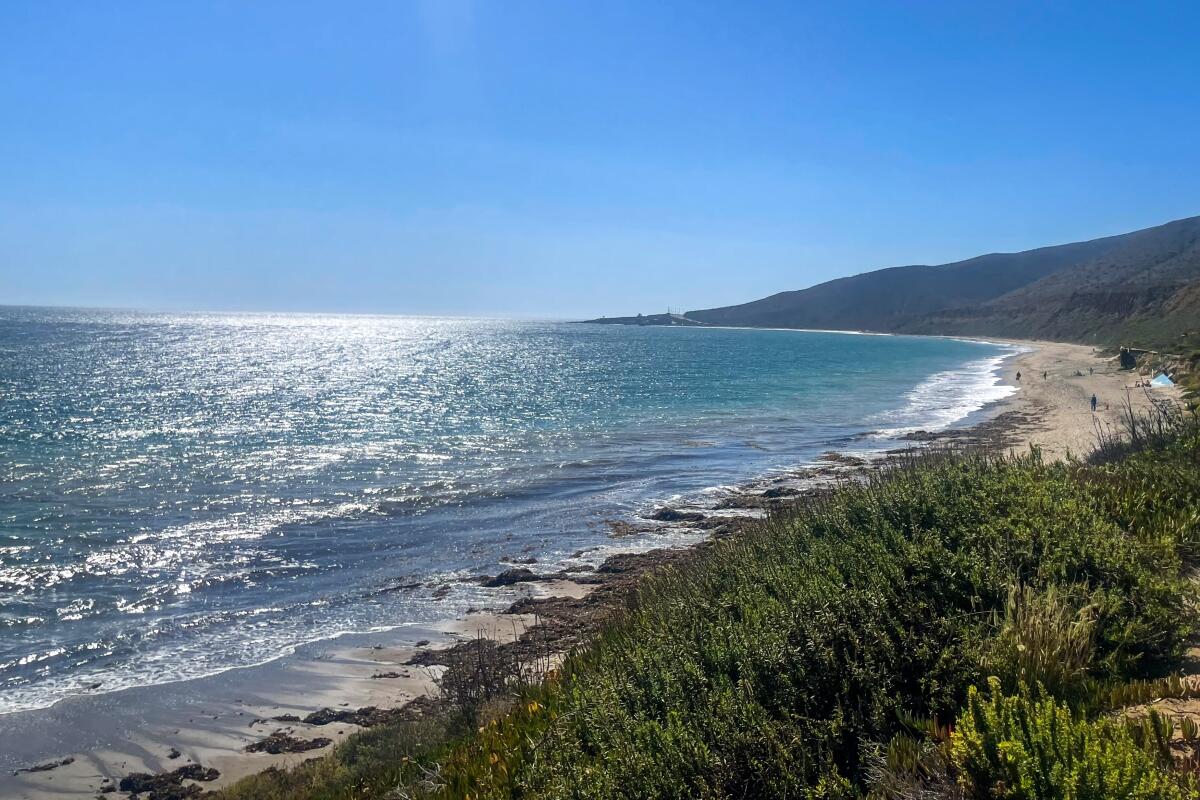
Nicholas Canyon County Beach
Plug the name of the beach into your GPS to avoid having to make unnecessary U-turns on the busy highway like I did after driving past it more than once. There is a decent-size parking lot with nearly 150 spots, including a few ADA spaces. Parking runs $3 to $10 in the winter and $3 to $12 in the summer. If the lot is full, you can park on PCH, but look out for “no parking signs.”
The beach is commonly referred to as “Zeros” or “Point Zero” because it’s one of the few spots where surfers can find the perfect point break. If you’re not surfing, though, Nicholas Canyon County Beach is a great spot to host an intimate picnic with a gorgeous view of the water — there are several tables and benches in the lot and near the lifeguard shack on the lower level of the beach. It also has multiple restroom facilities. You’ll have to walk down two flights of stairs to access the long, sandy beach.
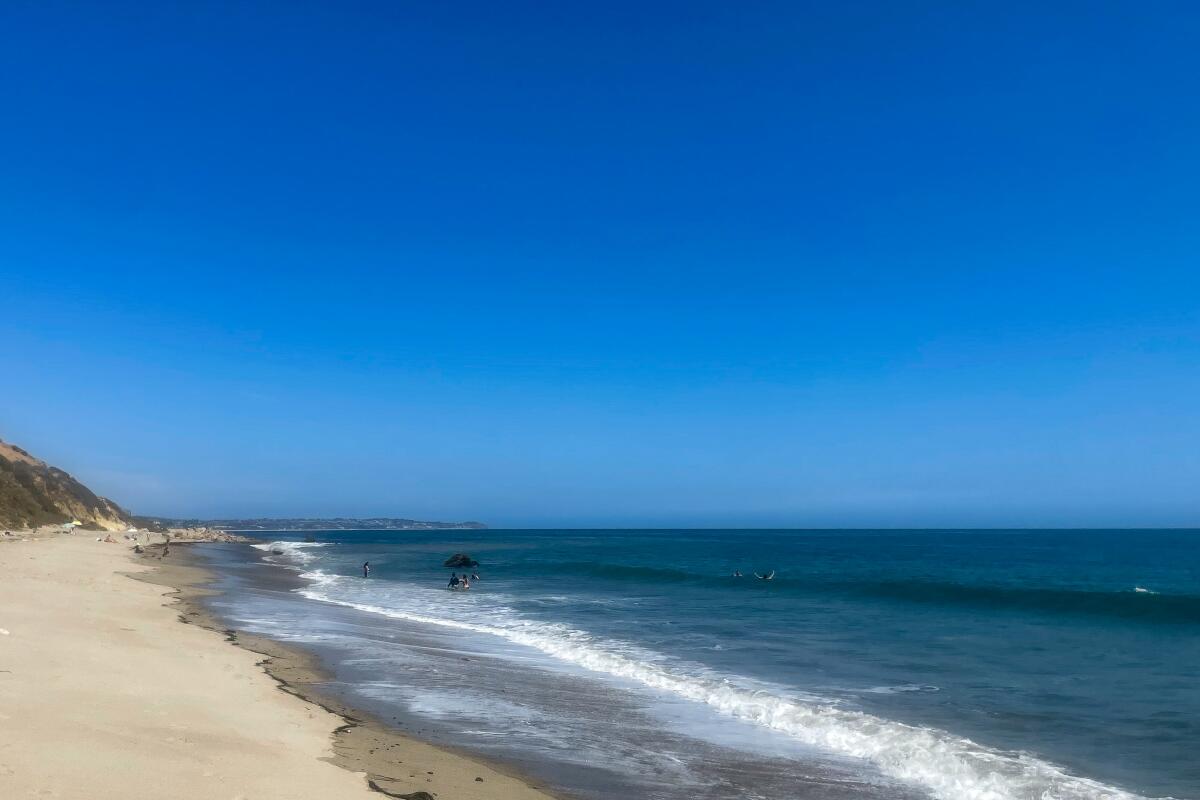
El Pescador State Beach
I’ve included it on this guide because you can easily get tripped up on which of the multiple trails to take to get to the beach. I recommend the dirt pathway to your right from the parking lot. (I spoke with a few people who were also visiting El Pescador for the first time and they said the various trails confused them as well.) The pathway isn’t flip-flop-friendly, so wear shoes with some grip to avoid slipping. Toward the end of the trail, I decided to slide down on my butt because I was wearing slip-on Vans and feared falling. However, I saw a group of sandal-wearing children navigate the pathway without incident. This beach doesn’t have any lifeguard towers.
You can park in the lot with roughly 20 spots for $12 for the day and $3 per hour, or along PCH for free.
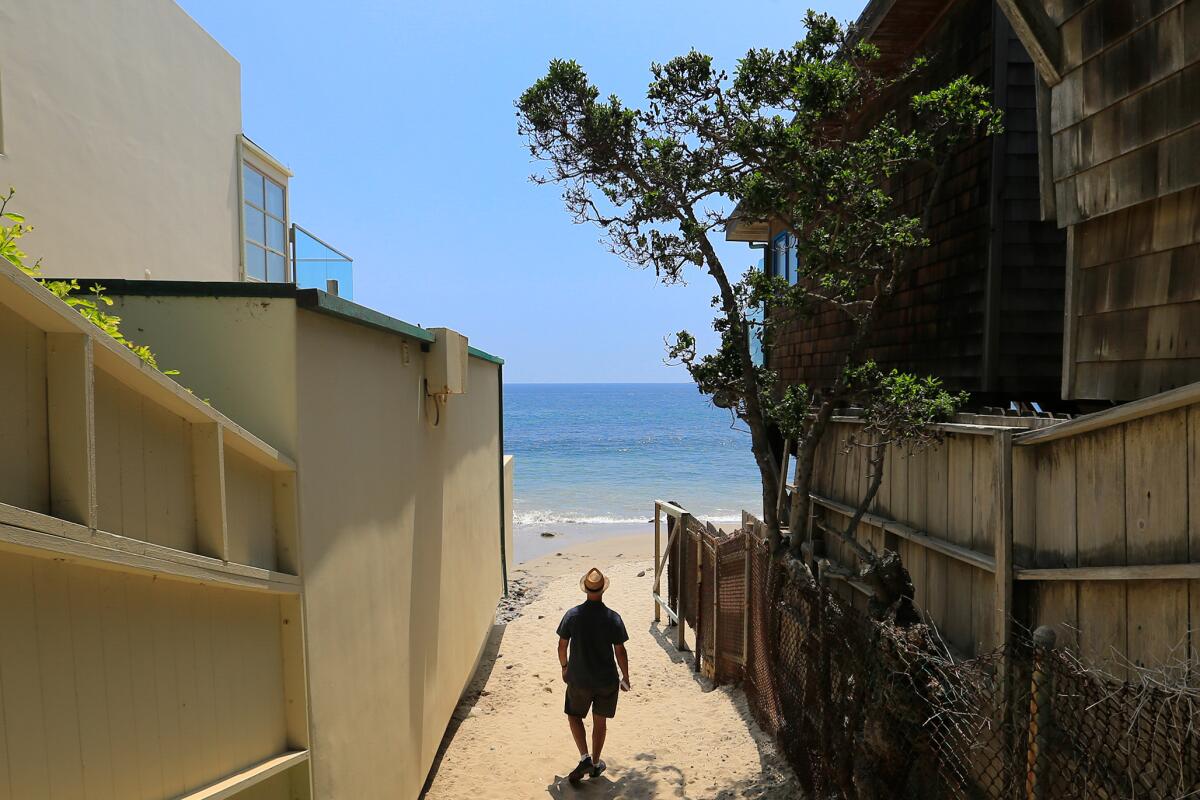
Malibu Road Beaches
These beaches have a whopping seven access points — the most of all in this guide. I recommend plugging “Malibu Road East Beach Access” into your GPS instead of using the Our Malibu Beaches app’s GPS as it may lead you to believe you’ve passed the access points. If you’re traveling south on California 1, make a right onto Webb Way. A good marker is the shopping plaza on the right side, which has a Starbucks and a Ralphs. Then make a quick right onto Malibu Road.
Use whichever beach entrance is closest to where you find parking on this lengthy public street. However, if you don’t mind the walk through the residential neighborhood, access No. 7 is a good entry point because it has the only all-public stretch on the Malibu Road beaches, meaning you can go anywhere on the beach and use all the wet sand on either side.
Many of the access points are tucked between houses, and if you scan them too quickly, you can easily miss them. Once you spot the access sign for Entrance No. 7, walk down a wide wooden staircase. There are also benches on the staircase, which provide a nice space to hang out if you don’t feel like going onto the actual beach. At the end of the staircase is a short path of rocks you’ll have to step over to reach the sand.
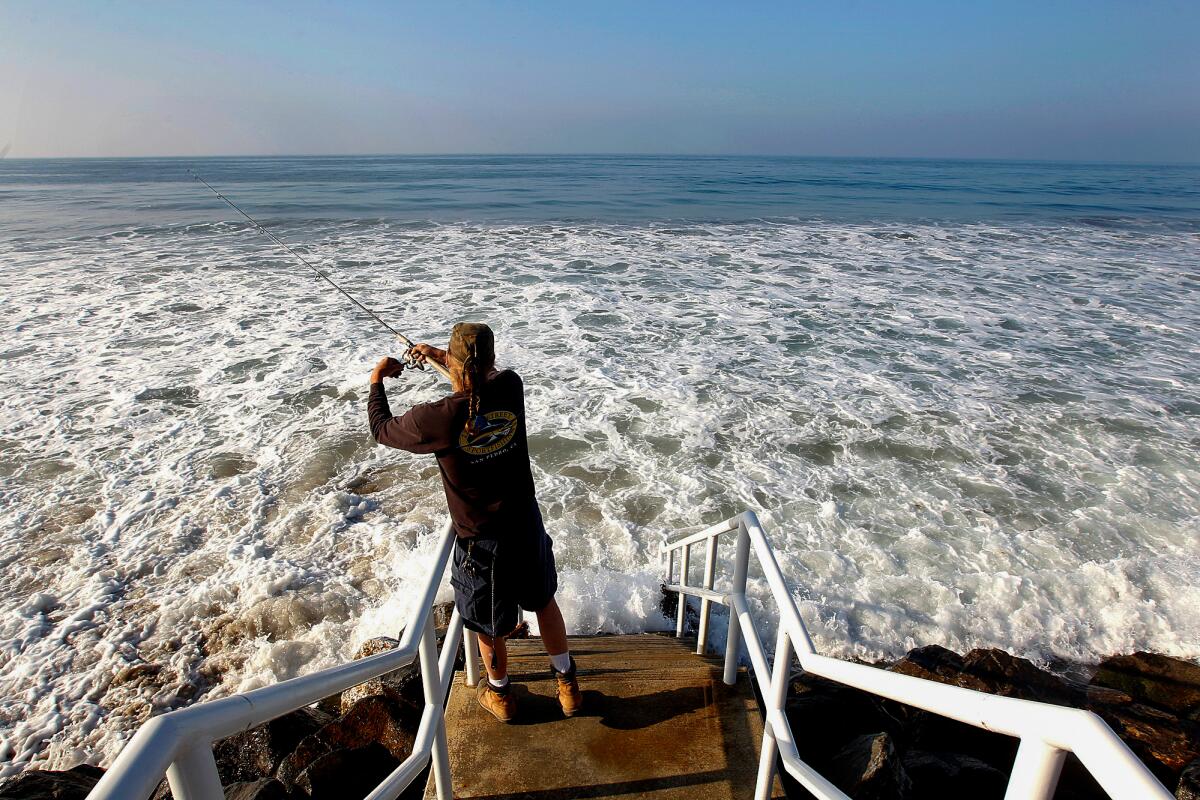
Broad Beach
This beach can get busy, especially during the weekend, so be prepared to walk once you find parking on Broad Beach Road, where it’s public and free. Follow the flow of people or use the GPS feature on Our Malibu Beaches app to find one of the three access ways. (I used access way No. 2 on a recent visit.) Look for the pedestrian gate with the blue access placard that sits between two houses, then walk down a short stairway along a sandy path that brings you to another set of stairs.
Broad Beach is family-friendly, and even though you are technically not allowed to bring dogs — as it’s clearly indicated on the access sign — you might still see some here. There aren’t any lifeguard towers, but because it’s so popular, lifeguards regularly respond to this area, according to Pono Barnes, who oversees lifeguard services for the Los Angeles County Fire Department.
Sign up for The Wild
We’ll help you find the best places to hike, bike and run, as well as the perfect silent spots for meditation and yoga.
You may occasionally receive promotional content from the Los Angeles Times.
